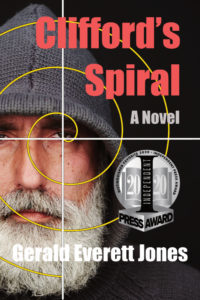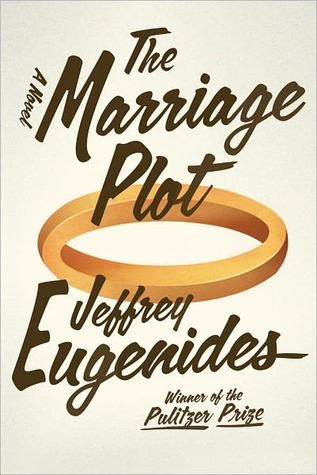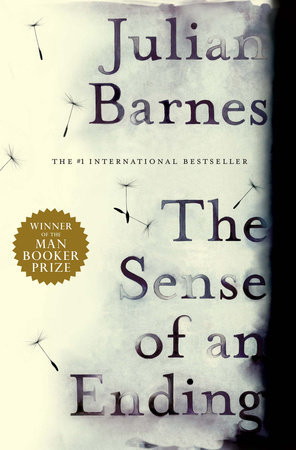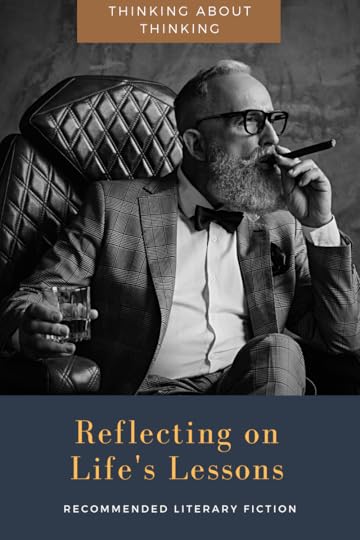Gerald Everett Jones's Blog: Gerald Everett Jones - Author, page 41
January 30, 2021
Thinking About Thinking #6 – Ballad of the Black and Blue Mind – Is EVERYBODY crazy?
 It’s understandable that people in lockdown go stir crazy. But some brain specialists believe that mental stability is a delicate balance for everyone, all the time. Here’s another work of literary fiction that will get you thinking about thinking.
It’s understandable that people in lockdown go stir crazy. But some brain specialists believe that mental stability is a delicate balance for everyone, all the time. Here’s another work of literary fiction that will get you thinking about thinking.
I offer for your thoughtful consideration Ballad of the Black and Blue Mind by Anne Roiphe.
If you’re in therapy or considering it, you may find this novel unsettling. But perhaps also strangely comforting. It’s about Manhattan psychiatrist Dr. Estelle Berman, and two of her colleagues – middle-aged men identified only as Dr. H and Dr. Z. Most of the other characters in the book are their students or their patients. And all of these lives intersect and become entangled.
[image error][image error]To some of her patients and even her friends, Dr. Berman can seem cold and calculating. She thinks of herself as wise and practical. All of the therapists in this story are trying improve the lives of their patients, who range from troubled to disturbed, many of them needing medication but not hospitalization.
There’s Justine, the gorgeous young movie star, who is anorexic and a kleptomaniac. There’s homely and lonely Anne, who fears she’s unlovable and gets coaxed out of the closet, only to be jilted. And the doctors refer their own children to each other for treatment. Dr. Z’s daughter Ronit is stressed because she can’t get pregnant, then Dr. Z is stressed about the possible complications when he finds out she’s carrying twins.
These are psychiatric case histories flavored with personal drama. We get insight into the mental processes and disorders of the patients, as well as those of their doctors. Because from Roiphe’s vantage point, all human minds are troubled. It’s just that some of us live with our demons better than others.
This is Anne Roiphe’s tenth novel, and she’s been described as a first-generation feminist. She’s also done nonfiction books and articles on family issues and mental health. She has an insider’s grasp of the psychiatric profession, and at times it’s not at all flattering.
Ballad of the Black and Blue Mind is a peek into the tangled psyches of a few intelligent people, most of them well-to-do and white, in today’s New York City. To paraphrase the narrator of the old TV series, “There are eight million stories in the Naked City. This is just a few of them.” And whether outwardly healthy or visibly disturbed, each of us suffers daily from self-doubt, jealousy, rage, guilt, arrogance, fears, phobias, and nightmares.

In Clifford’s Spiral a stroke survivor tries to piece together the fragments of his memories. Was he the victim or the perpetrator? 2020 IPA Distinguished Favorite in Literary Fiction.
The post Thinking About Thinking #6 – Ballad of the Black and Blue Mind – Is EVERYBODY crazy? appeared first on Gerald Everett Jones - Author.
January 27, 2021
Thinking About Thinking #5 – The Map and the Territory – Does genius boggle the mind?
It’s perhaps a stereotype that great artists are tortured souls. Here’s a murky book by a quirky novelist. And it’s fascinating, even if I don’t quite understand it all.
[image error][image error]Here’s my review of The Map and the Territory by contemporary French novelist Michel Houellebecq.
This author is unabashedly and unashamedly literary and intellectual. Those of us on this side of the pond who fret about novels and commercialism and fads and attention spans and the general lack of receptiveness for ideas can only envy the opportunity to wax philosophical and not only get away with it, but also actually sell books.
This is the story of a fine artist, Jed Martin, and the rationale behind various distinct phases of his work. It is also a police procedural about a ghastly murder. One connection is that the murder was performed in such a way as to create a work of art. This second story has very little to do with the main plot line of Jed’s work life. Jed’s difficult relationship with his aging master-architect father is a subplot upon which many heady sub-themes are hung, including the history and philosophy of architecture, the relationship between habitation and quality of life, and no less than the fate of civilization.
In perhaps the most stunning stroke of hubris in a work chockfull of it, occurring some way into the narrative so it’s a surprise when it comes, Houellebecq makes himself a principal character. By name. The relationship between life and art is open to question – that is, between the physical description of the French novelist, his eccentricities, and his volatile temperament. The Houellebecq in the narrative is not what you’d call a nice person – and certainly not someone you’d probably consider taking on as a friend. The author seems proud he’s alienating you, else why talk so unashamedly of his body odor and atrocious manners?
Main character Martin’s life is well-to-do Parisian, but mundane. He has an extended affair, off and on, with a Russian media executive named Olga. She is one hot babe, apparently, but even she can’t hold his interest. She did abandon him for a time, and perhaps an infantile ego can never forgive the ultimate insult of abandonment.
I’m somewhat mystified. I may reread it someday to study what I missed on first reading, which is probably a lot. I do know that, based on his descriptions of Martin’s paintings, I’d love to see them. I expect they would be photorealistic and iconic – like the old Chinese Communist propaganda posters. One of the delights of the book is imagining what these fictional works would look like.
My mystery-thriller about art history, which centers on a scandal rather than a forgery, is Bonfire of the Vanderbilts.
[image error][image error]A hundred-year-old secret locked is in a painting. The painting’s owner, Los Angeles Museum of Art, refuses to admit I got it right. But, hey, it’s fiction, the art historians say. Why should anyone take it seriously? What, according to my decades-long research into this painting that obsessed me so, did Cornelius Vanderbilt II not want you to know? Hint: Vanderbilt and his reputed mentor, banker J. P. Morgan, were rivals in the Episcopal Church hierarchy, each claiming to be more righteous than the other.
The post Thinking About Thinking #5 – The Map and the Territory – Does genius boggle the mind? appeared first on Gerald Everett Jones - Author.
January 23, 2021
Thinking About Thinking #4 – The Last Days of Ptolemy Grey – What if you found new romance at the end of your life?
Walter Mosley is best known for his prolific detective fiction. But this book is a fond, thoughtful story about a man who finds reasons to live just when he doesn’t have much time left.
Here’s my book review.
The Last Days of Ptolemy Grey isn’t a whodunit. It’s artful, introspective literary fiction about a 91-year-old man near the end of his life.
[image error][image error]Ptolemy Grey lives by himself in a shabby one-bedroom apartment in a poor neighborhood in Los Angeles. His place is stacked with the trash of a lifetime. You see, he hasn’t paid any attention to it since he woke up one morning to find his beloved last wife Sensia lying dead beside him.
When Sensia passed, he threw a tarp over everything in the bedroom and closed the door. He now sleeps on a mattress under a table in the kitchen. He rarely goes out, except when his grand-nephew Reggie walks him to the store for a few meager supplies. And he’s terrified to open the door for anyone.
The narrative is full of Ptolemy’s fretful thoughts. He has outlived almost all of his closest friends and loved ones. And early in this story, he finds that Reggie has been killed in a drive-by shooting.
Another nephew, Hilly, drops by to take him to Reggie’s wake. There Ptolemy meets Robyn, a gorgeous, slender girl who is about to turn eighteen. She decides to take care of him, becoming his last love, albeit platonic, but intense as any of the romances in his long life.
As Ptolemy says to her: I love you and I couldn’t be here right now if it wasn’t for you taking care of me. And if you were twenty years older and I fifty years less I’d ask you to be my wife and not a soul on this earth would have ever had better.
This may well be Walter Mosley’s best book.
In 2013 actor Samuel L. Jackson said in an interview with Red Carpet News TV that he had acquired the movie rights to Ptolemy Grey. As of this writing, IMDBPro.com reports that it is in development for Apple TV.

In Clifford’s Spiral a stroke survivor tries to piece together the fragments of his memories. Was he the victim or the perpetrator? 2020 IPA Distinguished Favorite in Literary Fiction.
The post Thinking About Thinking #4 – The Last Days of Ptolemy Grey – What if you found new romance at the end of your life? appeared first on Gerald Everett Jones - Author.
January 20, 2021
Thinking About Thinking #3: The Forgery of Venus – Is art forgery a victimless crime?
Is art forgery a victimless crime? The owners of paintings valued in the millions of dollars are either high-net-worth individuals or or cathedrals or museums. And, yes, international mobsters and oligarchs have been rumored to use them as mediums of exchange in drug deals and money-laundering schemes. Some would argue that a truly masterful forgery, aside from being a fraud, actually preserves cultural history and works that might otherwise be lost or deteriorated. That is – for the museum patron or the visitor to an aristocratic household – what’s the difference in the thrill of seeing it?
What do you think?
[image error][image error]Here’s my book review of The Forgery of Venus by Michael Gruber. Thanks to Judy Wisdomkeeper’s comment on Goodreads for recommending this book.
Gruber’s writing style has a voice, and right away that puts him at the top of my list. Besides the plotting, which goes back and forth in time in ways I’ve never experienced in a book, The Forgery of Venus fascinates in two other ways – its meticulous description of painting technique and its depiction of mental illness. Peter Carey’s Theft, which I also enjoyed, also has these two elements. The neurological issues are reminiscent of another masterpiece novel, The Marriage Plot by Jeffrey Eugenides, which I reviewed in Thinking About Thinking #2.
The protagonist of this novel is Chaz Wilmont, an accomplished fine arts painter. He’s a brilliant technician but insecure about his creativity. His insecurity is rooted in the emotional abuse he received from his father, who was also a famous painter and intensely jealous of his son.
Wilmont is also pretty much a failure in his personal relationships. He’s divorced two wives, and he’s not a particularly attentive father to his children. Then a bizarre thing happens. Chaz volunteers as a patient in a pharmaceutical research study. He’s given a psychoactive drug that induces hallucinations. But in Chaz the effect is unique and disturbing. He seems to bi-locate physically as well as mentally into another person’s body at another time in history. He finds himself living in Madrid in the 1650s. Having assumed the identity of Diego Velazquez, one of the most supremely gifted painters who ever lived, in this past life Chaz learns all Velazquez’s techniques, one brushstroke at a time.
Back in the present day, international criminals discover Wilmot’s talent and blackmail him into forging a Velazquez painting that has been missing for centuries.
I find two things remarkable about this book: First, perhaps because Gruber is married to a painter, his descriptions of painterly techniques are vivid and detailed. Second is the theme of altered mental states. As Chaz shuttles back and forth between the centuries, he begins to wonder, What is reality? What is personal identity? How can you be so sure you are the person you think you are? And what difference would it make if your favorite painting by an old master just a masterful forgery?
Gruber also hints, as other writers of art-history novels have, that many great painters of yesteryear made a living forging the works of their predecessors as they studied and then copied their techniques. A painting the experts think is a Titian could be from Rembrandt’s workshop of apprentices, for example.
My mystery-thriller about art history, which centers on a scandal rather than a forgery, is Bonfire of the Vanderbilts.
[image error][image error]A hundred-year-old secret locked is in a painting. The painting’s owner, Los Angeles Museum of Art, refuses to admit I got it right. But, hey, it’s fiction, the art historians say. Why should anyone take it seriously? What, according to my decades-long research into this painting that obsessed me so, did Cornelius Vanderbilt II not want you to know? Hint: Vanderbilt and his reputed mentor, banker J. P. Morgan, were rivals in the Episcopal Church hierarchy, each claiming to be more righteous than the other.
The post Thinking About Thinking #3: The Forgery of Venus – Is art forgery a victimless crime? appeared first on Gerald Everett Jones - Author.
January 17, 2021
Thinking About Thinking #2: The Marriage Plot – Does the old story still work?
 For generations, a staple of romantic fiction has been a genre called the marriage plot. An underprivileged female protagonist must find a rich, aristocratic husband, or her life will be ruined. Her choices for the future will be to enter a convent or resign herself to spinsterhood.
For generations, a staple of romantic fiction has been a genre called the marriage plot. An underprivileged female protagonist must find a rich, aristocratic husband, or her life will be ruined. Her choices for the future will be to enter a convent or resign herself to spinsterhood.
Second in a series of posts with my book reviews of literary fiction – the kind of stuff that, well, made me think.
My book review and reading suggestion for this installment is The Marriage Plot by Jeffrey Eugenides. It’s a contemporary story about four friends, which begins when they meet in college at Brown. It updates the question embedded in the old theme.
It’s about whether we understand anything about what makes relationships work.
Here’s my book review of The Marriage Plot, a novel by Jeffrey Eugenides.
The Marriage Plot is masterful on many levels. At first I wasn’t drawn to any of the three characters in the love triangle – Madeleine, Leonard, and Mitchell. Each seemed deeply flawed, and they are. Except you read along and find that Eugenides thinks we all are, just as deeply in our unique ways, and are none the lesser for it. That’s the way people are, and the way life goes. We stumble through it, thinking we are somehow in control, and it’s what happens nevertheless while we are furiously busy making other plans, or simply fretting about making up our minds.
 This is a literary novel, in the best sense, and I was surprised to read some critics cramming it into the diminutive genre “campus novel.” That would be like classifying Pride and Prejudice as a rom com, which is not as irrelevant as it sounds. The marriage plot, you see, is the genre form of which that work is representative. Eugenides wants to know whether the marriage plot is dead as a meaningful literary form, now that marriage seems hardly worthy as the ultimate goal of youthful aspirations.
This is a literary novel, in the best sense, and I was surprised to read some critics cramming it into the diminutive genre “campus novel.” That would be like classifying Pride and Prejudice as a rom com, which is not as irrelevant as it sounds. The marriage plot, you see, is the genre form of which that work is representative. Eugenides wants to know whether the marriage plot is dead as a meaningful literary form, now that marriage seems hardly worthy as the ultimate goal of youthful aspirations.
But back to Eugenides. The characters meet in a semiotics class at Brown, and the author gives a lot of detail aboutthe subject and its impact on their personal thoughts. Semiotics claims, for example, that humans would not experience love as we have come to understand it unless we had read about it (or seen movies about it) first. There’s a similar concept in Stendhal’s The Red and the Black. The narrator comments that peasants in the French countryside cope with life less well than the sophisticated citizens of Paris, who have all read novels that give them models for how to act in society.
Ultimately, this is a novel about perception, what we make of reality as it is happening to us, and our inability to make meaning of events in time to control their outcome. Things happen or they don’t. Things work out or they don’t. They mostly don’t, and we move on.
Perhaps significantly, the character in this book who understands himself best is the one whose grasp on reality is most tenuous because he has to work at staying sane. In his acknowledgements, Eugenides credits several experts and sources for genetic research (another theme), but he thanks no one for his extensive detailing of bipolar disorder and its treatment. So naturally I wonder how he came by this information, and at what personal cost. ~ ~ ~

In Clifford’s Spiral a stroke survivor tries to piece together the fragments of his memories. Was he the victim or the perpetrator? 2020 IPA Distinguished Favorite in Literary Fiction.
The post Thinking About Thinking #2: The Marriage Plot – Does the old story still work? appeared first on Gerald Everett Jones - Author.
January 10, 2021
Thinking About Thinking #1 – The Sense of an Ending
Is this a candid photo of author and show host Gerald Everett Jones? No. When I tried to grow a beard it never looked this good. This guy is probably about my age, though, and his is the mood I want to share with you – thinking about thinking. Thinking about writers and writing. Thinking about reading. And thinking on those thoughts and emotions that writing and reading stir in us.
So I’m starting a series of posts with my book reviews of literary fiction – the kind of stuff that, well, made me think.
My first suggestion is The Sense of an Ending by Julian Barnes. A few years ago, it won the Man Booker Prize. It was an inspiration for my own Clifford’s Spiral, which won Distinguished Favorite in the Independent Press Awards last year.
It’s about trying to make sense of what you remember about your life’s experiences.
 You will either be fascinated by The Sense of an Ending, or it just might infuriate you.
You will either be fascinated by The Sense of an Ending, or it just might infuriate you.
Main character Tony Webster is middle-aged and reflecting back on his life. Just when he thinks he has it all sorted, he has to cope with troublesome consequences from choices he made as a young man. He has to face the possibility that he may have been responsible for his best friend’s death, and he may be the father of an illegitimate child.
The two people who know the facts are gone. The third isn’t talking, and her diary, which could have revealed everything, is probably lost.
Barnes shows us how Tony rewrites history so as to make himself the hero of his own story. Or, at the very least, justify his actions. And, so do all of us. Families, communities, and nations continually adjust the favorable light on their actions over time.
Why might you be infuriated? Because, bravely I think for an author, Barnes provides only the sense of an ending.
The following analysis won’t make any sense at all unless you’ve already read the book.
[So, quadruple spoiler alert!]
To recap, Tony was in love with Veronica and best friends with Adrian. Adrian married Veronica and then ended his own life. This much, Tony believes he knows. Adrian left a cryptic formula that may have been meant as a suicide note.
In terms of overt clues and Adrian’s equation, Adrian had an affair (perhaps not so brief, near the end of his life) with Veronica’s mother Sarah, who bore a child, also named Adrian, who was later sent (after Sarah’s death?) to a caregiver facility.
What nags at Tony at the end is that there are other possibilities that could fit the evidence better. Unless Veronica spills it, or the telltale diary is not burnt after all, Tony can never know for sure. In all scenarios he’s guilty, in some achingly more than in others.
The child could have been Veronica’s by Adrian or by Tony. The memory of a trip to the river seems to imply a night of unprotected, romantic sex. Sarah might have cared for the baby when Veronica couldn’t, or wouldn’t. Veronica’s pregnancy would have been when she and Adrian were newlyweds. He might have died thinking the baby was his. Or sure that it wasn’t. Or not sure at all and tormented by it.
Tony says the child (seen now as a young man) looks like the presumed father, his old friend Adrian. But did Tony look like Adrian? Is Tony looking into a mirror and denying the familiarity he sees? Is Tony’s remarking on the resemblance a clue to throw us off the track?
The child could have been Sarah’s by Tony. This strange possibility best explains: 1) Sarah’s bequest, 2) Veronica’s rage, and 3) Sarah’s enigmatic parting gesture to Tony, implying a secret they shared (that she’d seduced him during his visit). The fact that Tony has repressed the memory of the sex act (but not the washing up after) would seem totally implausible, except in the context of this book which is all about how our minds rewrite history to suit our opinion of ourselves.
You might well ask, “Huh?”
# # #
The post Thinking About Thinking #1 – The Sense of an Ending appeared first on Gerald Everett Jones - Author.
August 23, 2020
What Should You Know About The Marriage Plot?
Every now and then, Goodreads emails me a notice that someone liked one of my book reviews on the site. One that has drawn a long thread of comments is on The Marriage Plot by Jeffrey Eugenides. It remains one of my favorite novels. So grab that coffee, and here are my thoughts:
Masterful on many levels. At first I wasn’t drawn to any of the three characters in the love triangle – Madeleine, Leonard, and Mitchell. Each seemed deeply flawed, and they are. Except you read along and find that Eugenides thinks we all are, just as deeply in our unique ways, and are none the lesser for it. That’s the way people are, and the way life goes. We stumble through it, thinking we are somehow in control, and it’s what happens nevertheless while we are furiously busy making other plans, or simply fretting about making up our minds.
This is a literary novel, in the best sense, and I was surprised to read some critics cramming it into the diminutive genre “campus novel.” That would be like classifying Pride and Prejudice as a rom com, which is not as irrelevant as it sounds. The marriage plot, you see, is the genre form of which that work is representative. Eugenides wants to know whether the marriage plot is dead as a meaningful literary form, now that marriage seems hardly worthy as the ultimate goal of youthful aspirations.
[image error]Then there’s the theme of semiotics. I studied with Roland Barthes (yes, I’m that old), and back then I don’t think the term semiotics even existed. At least, I don’t recall his ever having used it. But he talked incessantly about structuralism, that a novel is a long sentence spoken by its author, a literary construct waiting to be parsed. Understand, I didn’t get any of this from him back then, just from what others, including Susan Sontag, have written about him since. His lesson plan was built around Balzac’s short story “Sarrasine,” which is the engrossing tale of a man obsessed by an opera star who turns out to be both a castralto and the “kept woman” of a powerful priest. But why Barthes chose that story for his criticism totally escaped me at the time, and I can only surmise now what his intentions were.
But back to Eugenides. The characters meet in a semiotics class at Brown, and the author gives a lot of detail about the subject and its impact on their personal thoughts. Semiotics claims, for example, that humans would not experience love as we have come to understand it unless we had read about it (or seen movies about it) first. There’s a similar concept in Stendhal’s The Red and the Black, in which the narrator comments that peasants in the French countryside cope with life less well than the sophisticated citizens of Paris, who have all read novels that give them models for how to act in society.
Ultimately, this is a novel about perception, what we make of reality as it is happening to us, and our inability to make meaning of events in time to control their outcome. Things happen or they don’t. Things work out or they don’t. They mostly don’t, and we move on.
Perhaps significantly, the character in this book who understands himself best is the one whose grasp on reality is most tenuous, because he has to work at staying sane. In his acknowledgements, Eugenides credits several experts and sources for genetic research (another theme), but he thanks no one for his extensive detailing of bipolar d[image error]isorder and its treatment. So naturally I wonder how he came by this information, and at what personal cost.
Cross-posted on Goodreads.com.
Ahem, I recently published a literary novel, Clifford’s Spiral. I know that genre – which is defined mainly by not fitting in any genre – is challenging to promote – and possibly difficult for new readers to discover. But it did win an Independent Press Association Distinguished Favorite Award this year in the Literary Fiction category. It’s not about a marriage so much as it is about a stroke victim reflecting back on marriages and relationships and trying to make some sense of his fragmented memories.
[image error]
The post What Should You Know About The Marriage Plot? appeared first on Gerald Everett Jones - Author.
August 19, 2020
Storytelling and the Subconscious
I recently finished the manuscript of Preacher Fakes a Miracle. I’m amazed once again at the role of my subconscious in the writing process. When I used to write business and technical books, it was all laid out in advance, outlined to the last chapter, peppered with bullet points. The publisher’s editor would track my progress diligently, requiring me to submit one or two chapters a week for ten weeks or more of daily, diligent effort. And I either sketched illustrations for the artist or provided photos I’d taken myself. Then they usually made me build the index (no fun).
But after ten novels now, I can honestly say that for most of them I had little notion of where they would end up, almost from the first page. The exceptions were the three books I adapted from unsold screenplays – the rom-com My Inflatable Friend, the huckster madcap misadventure Mr. Ballpoint, and the family melodrama Christmas Karma. Even then, the writing was beset by inventive surprises. I had to learn the lesson, for example, that the novelist must paint what the camera sees. Duh. Writing between the lines of the script, you could call it. (When it’s in dialogue, those clever actors call it subtext.)
But the joy and the agony and the thrill of making it up as you go along in fiction are bound up in trusting where it’s all going. I’d put in a quirk or a character detail and then forget about it. Fifty or a hundred pages later, that info-morsel would figure into some plot twist – proving to be a significant clue or motivation.
And that surprise is my delight, frankly. I boasted to some of the beta readers of Preacher Finds a Corpse that I didn’t really know how the plot would ultimately get resolved until I wrote the last page. And a couple of them concurred with me that they were also guessing until the very end.
And the experience of finishing Preacher Fakes a Miracle has been much the same. I wrote the last sentence of the last chapter and thought, Wow, that’s what I was going for! That ties it up! And then I realized the next day that there remained an unanswered question (what Dan Brown calls a promise to the reader). So, remembering I had a Prologue (one bookend), I realized that neat construction and a stable bookcase, as well as paying off that debt, required an Epilogue.
Another delicious surprise!
The post Storytelling and the Subconscious appeared first on Gerald Everett Jones - Author.
June 10, 2020
Subconscious writing surprises and delights
I just finished the manuscript of Preacher Fakes a Miracle, which is the sequel to the first Evan Wycliff mystery, Preacher Finds a Corpse.
I’m overcome by a mix of emotions and conflicted thoughts.
I’m amazed once again at the role of my subconscious in the writing process. When I used to write business and technical books (of which there have been more than thirty), it was all laid out in advance, outlined to the last chapter, peppered with bullet points. The publisher’s editor would track my progress diligently, requiring me to submit one or two chapters a week for ten weeks or more of daily, diligent effort. And I either sketched illustrations for the artist or provided photos I’d taken myself. Then they usually made me build the index (no fun).
But after ten novels now, I can honestly say that for most of them I had little notion of where they would end up, almost from the first page. The exceptions were the three books I adapted from unsold screenplays – the rom-com My Inflatable Friend, the huckster madcap misadventure Mr. Ballpoint, and the family melodrama Christmas Karma. Even then, the writing was beset by inventive surprises. I had to learn the lesson, for example, that the novelist must paint what the camera sees. Duh. Writing between the lines of the script, you could call it. (When it’s in dialogue, those clever actors call it subtext.)
But the joy and the agony and the thrill of making it up as you go along in fiction are bound up in trusting where it’s all going. I’d put in a quirk or a character detail and then forget about it. Fifty or a hundred pages later, that info-morsel would figure into some plot twist – proving to be a significant clue or motivation.
And that surprise is my delight, frankly. I boasted to some of the beta readers of Preacher Finds a Corpse that I didn’t really know how the plot would ultimately get resolved until I wrote the last page. And a couple of them concurred with me that they were also guessing until the very end.
And the experience of finishing Preacher Fakes a Miracle has been much the same. I wrote the last sentence of the last chapter and thought, Wow, that’s what I was going for! That ties it up! And then I realized the next day that there remained an unanswered question (what Dan Brown calls a promise to the reader). So, remembering I had a Prologue (one bookend), I realized that neat construction and a stable bookcase, as well as paying off that debt, required an Epilogue.
Another delicious surprise!
Do you surprise yourself when you write? When you read?
[image error]
Comp review copies available from ProlificWorks.com
The post Subconscious writing surprises and delights appeared first on Gerald Everett Jones - Author.
October 9, 2019
“Must Read” Review of Clifford’s Spiral on Reedsy Discovery
I want to thank Dorothyanne Browne for her Must Read rating with five stars and review of Clifford’s Spiral on the Reedsy Discovery book-fan website @reedsydiscovery She’s not an acquaintance of mine (unlike some of my diligent beta reviewers), but no doubt from her observations she is a kindred soul. Her bio states that she is a retired nurse. She’s currently writing a fiction trilogy as well as a self-help book for people with multiple sclerosis and other brain conditions. I’m sure her insights on the clinical aspects informed her review of Clifford Klovis’s struggle to make sense of reality after he’s had a major stroke.
She also appreciated the humor in it. #booklovers #litfic #newrelease
Dorothyanne wonders:
Where would your mind go, if you were trapped after a stroke? Would you find happy memories? Regrets? Or philosophic meanderings?
And here’s her conclusion:
Despite Clifford’s grumpy uncooperative self, the reader can’t help but cheer for him, hope he will release his chosen silence, and be able to speak again. Clifford is so well-drawn, and his life stories capture the reader so completely that you forgive him his vanity and selfishness, and wish the book was longer so you could hang out with him longer. Highly recommended. You will want to read this more than once.
You can read the full review here on Reedsy Discovery.
If you like this review and the book please click the Upvote button at the top of the review to recommend Clifford’s Spiral to fans of literary fiction.
SYNOPSIS
Clifford’s Spiral is a quirkily comic literary novel. Its sardonic tone recalls the wry wisdom of Kurt Vonnegut, and its preoccupation with male centeredness is reminiscent of Philip Roth. Stroke survivor Clifford Klovis tries to piece together the colorful fragments of his memories. He fusses over his lifelong curiosities about astrophysics and metaphysics, Christian faith and New Age philosophy, and why the spiral shape appears in bathtub drains and at the centers of galaxies. He has imaginary conversations and arguments with wives and lovers, as well as with Hypatia of Alexandria, René Descartes, his old mentor Reverend Thurston, and Stephen Hawking. Clifford’s best teacher turns out to be his paraplegic son Jeremy, who has found his father’s old letters and journals. Jeremy also wonders: Who was Clifford Olmstead Klovis?
More books by Gerald Everett Jones.
The post “Must Read” Review of Clifford’s Spiral on Reedsy Discovery appeared first on Gerald Everett Jones - Author.











